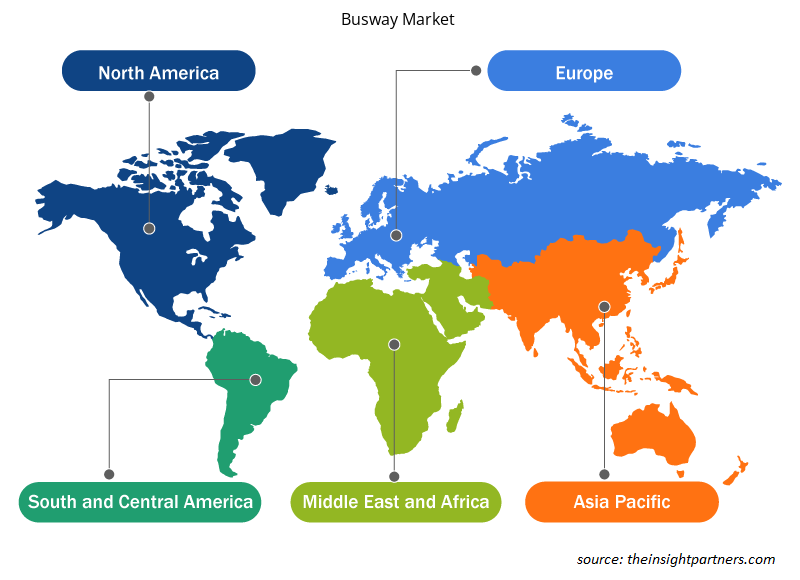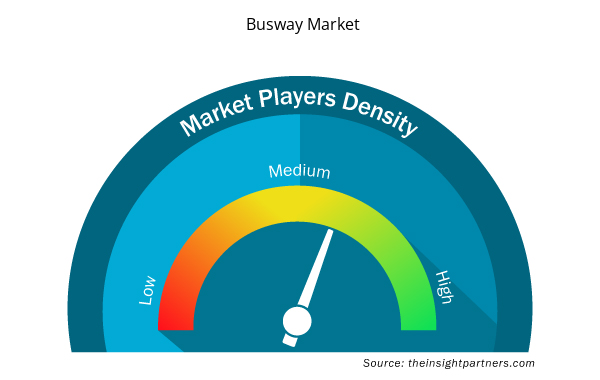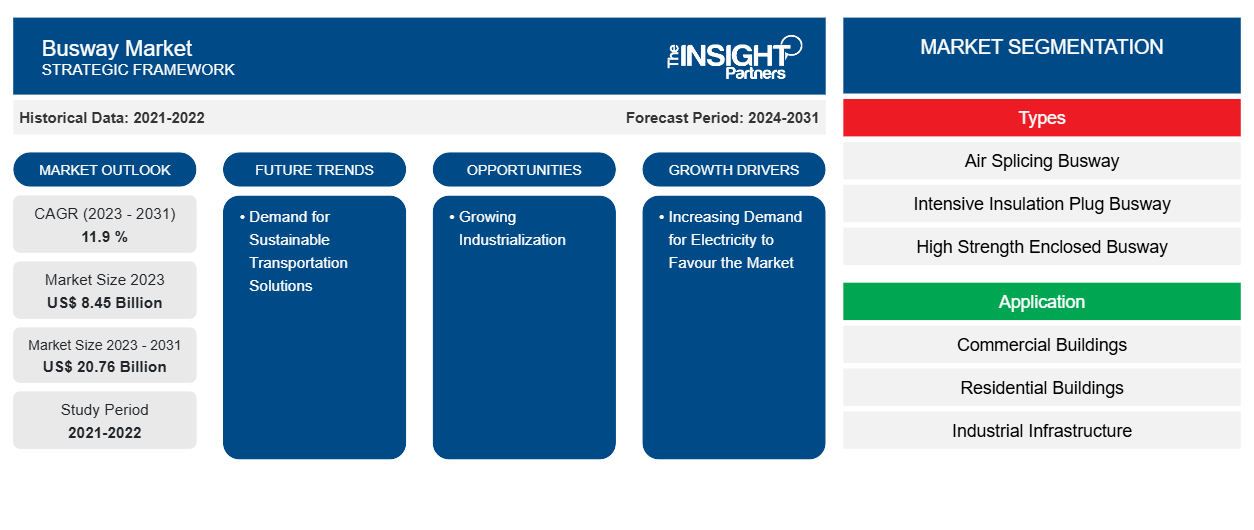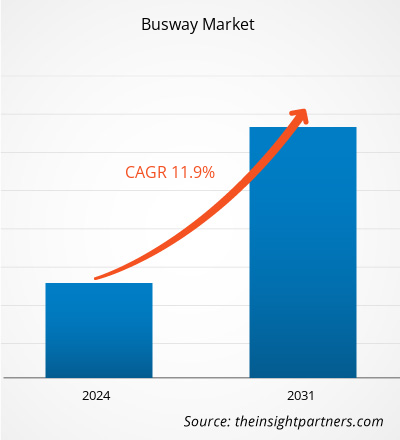Se proyecta que el tamaño del mercado de buses eléctricos alcance los 20.760 millones de dólares en 2031, frente a los 8.450 millones de dólares en 2023. Se espera que el mercado registre una CAGR del 11,9 % entre 2023 y 2031. Es probable que la creciente demanda de electricidad y la creciente industrialización sigan siendo tendencias clave en el mercado de buses eléctricos.
Análisis del mercado de vías para buses
Se observan diferentes tendencias de crecimiento en diferentes regiones de esta industria. Los mercados desarrollados de América del Norte (NA) y Europa (ELI) representan una parte importante de la participación de mercado global; sin embargo, los países en desarrollo en regiones como Asia Pacífico (APAC), Oriente Medio y África (ME), África y América del Sur (SAM) están creciendo rápidamente debido a una variedad de factores como la necesidad de electrificación y el crecimiento de nuevas industrias e infraestructura. Se prevé que la adopción de buses aumente rápidamente en los próximos años debido a la expansión de las redes eléctricas y el desarrollo de plantas de energía renovable a nivel mundial.
Descripción general del mercado de buses
La Asociación Nacional de Fabricantes Eléctricos (NEMA) define un electroducto como un sistema de distribución eléctrica prefabricado compuesto por tramos rectos, accesorios, dispositivos y conexiones, todos encerrados en una carcasa protectora. Los electroductos transportan energía y la vinculan a equipos eléctricos como transformadores, tableros de distribución y aparamenta . En aplicaciones comerciales e industriales, un electroducto es un excelente sustituto de los cables y conductos porque es más fácil de reemplazar, menos costoso de instalar y requiere menos trabajo de configuración, especialmente en escenarios donde es probable que varíen las posiciones de carga.
Personalice este informe según sus necesidades
Obtendrá personalización en cualquier informe, sin cargo, incluidas partes de este informe o análisis a nivel de país, paquete de datos de Excel, así como también grandes ofertas y descuentos para empresas emergentes y universidades.
- Obtenga las principales tendencias clave del mercado de este informe.Esta muestra GRATUITA incluirá análisis de datos, desde tendencias del mercado hasta estimaciones y pronósticos.
Factores impulsores y oportunidades del mercado de vías para buses
Aumento de la demanda de electricidad para favorecer al mercado.
El uso de electricidad ha aumentado en las últimas décadas y ahora es esencial para las economías modernas. Debido al aumento de la renta disponible, se prevé que esta demanda aumente en los próximos años. El aumento del consumo de electricidad ha dado lugar a un aumento del uso de electricidad en las industrias de consumo final y en los automóviles. Existen dos patrones geográficos diferentes para la demanda de electricidad. Las mejoras en la eficiencia energética contrarrestan el crecimiento futuro asociado con el aumento de la electrificación y la digitalización en las economías avanzadas.
Creciente industrialización
La creciente industrialización conduce al desarrollo de nuevas fábricas y plantas de fabricación, que requieren una infraestructura eléctrica robusta para alimentar maquinarias y equipos, creando una demanda de sistemas de buses para distribuir eficientemente la electricidad.busway systems to efficiently distribute electricity.
Análisis de segmentación del informe de mercado de vías para buses Market Report Segmentation Analysis
Los segmentos clave que contribuyeron a la derivación del análisis del mercado de buses son los tipos y las aplicaciones.busway market analysis are types and applications.
- Según los tipos, el mercado de electroductos se divide en electroductos con empalme de aire (BMC), electroductos con tapones de aislamiento intensivo (CMC), electroductos cerrados de alta resistencia (CFW) y otros.busway market is divided into air splicing busways (BMC), intensive insulation plugs busways (CMC), high-strength enclosed busways (CFW), and others).
- Por aplicación, el mercado está segmentado en edificios comerciales, edificios residenciales, infraestructura industrial y otros.
Análisis de la cuota de mercado de los buses por geografía Market Share Analysis by Geography
El alcance geográfico del informe de mercado de buses de buses se divide principalmente en cinco regiones: América del Norte, Asia Pacífico, Europa, Oriente Medio y África, y América del Sur/América del Sur y Central. América del Norte ha dominado el mercado de buses de buses. Las tendencias de adopción de alta tecnología en varias industrias en la región de América del Norte han impulsado el crecimiento del mercado de buses de buses. Además, un fuerte énfasis en la investigación y el desarrollo en las economías desarrolladas de los EE. UU. y Canadá está obligando a los actores norteamericanos a traer soluciones tecnológicamente avanzadas al mercado. Además, los EE. UU. tienen muchos actores del mercado de buses de buses que se han centrado cada vez más en el desarrollo de soluciones innovadoras. Todos estos factores contribuyen al crecimiento del mercado de buses de la región.busway market report is mainly divided into five regions: North America, Asia Pacific, Europe, Middle East & Africa, and South America/South & Central America. North America has dominated the busway market. High technology adoption trends in various industries in the North American region have fuelled the growth of the busway market. Moreover, a strong emphasis on research and development in the developed economies of the US and Canada is forcing the North American players to bring technologically advanced solutions into the market. In addition, the US has many busway market players who have been increasingly focusing on developing innovative solutions. All these factors contribute to the region's growth of the busway market.
Perspectivas regionales del mercado de buses
Los analistas de Insight Partners explicaron en detalle las tendencias y los factores regionales que influyen en el mercado de vías para buses durante el período de pronóstico. Esta sección también analiza los segmentos y la geografía del mercado de vías para buses en América del Norte, Europa, Asia Pacífico, Oriente Medio y África, y América del Sur y Central.

- Obtenga los datos regionales específicos para el mercado de vías para buses
Alcance del informe de mercado de vías para buses
| Atributo del informe | Detalles |
|---|---|
| Tamaño del mercado en 2023 | US$ 8,45 mil millones |
| Tamaño del mercado en 2031 | US$ 20,76 mil millones |
| CAGR global (2023 - 2031) | 11,9 % |
| Datos históricos | 2021-2022 |
| Período de pronóstico | 2024-2031 |
| Segmentos cubiertos | Por tipos
|
| Regiones y países cubiertos | América del norte
|
| Líderes del mercado y perfiles de empresas clave |
|
Densidad de actores del mercado de buses: comprensión de su impacto en la dinámica empresarial
El mercado de buses está creciendo rápidamente, impulsado por la creciente demanda de los usuarios finales debido a factores como la evolución de las preferencias de los consumidores, los avances tecnológicos y una mayor conciencia de los beneficios del producto. A medida que aumenta la demanda, las empresas amplían sus ofertas, innovan para satisfacer las necesidades de los consumidores y aprovechan las tendencias emergentes, lo que impulsa aún más el crecimiento del mercado.
La densidad de actores del mercado se refiere a la distribución de las empresas o firmas que operan dentro de un mercado o industria en particular. Indica cuántos competidores (actores del mercado) están presentes en un espacio de mercado determinado en relación con su tamaño o valor total de mercado.
Las principales empresas que operan en el mercado de buses son:
- Schneider Electric
- Siemens
- Comer
- Cables y sistemas LS
- Conducto de bus de enchufe de alimentación Sdn. Bhd.
- TEJIDO
Descargo de responsabilidad : Las empresas enumeradas anteriormente no están clasificadas en ningún orden particular.

- Obtenga una descripción general de los principales actores clave del mercado Busway
Noticias y desarrollos recientes del mercado de vías para buses
El mercado de buses se evalúa mediante la recopilación de datos cualitativos y cuantitativos a partir de investigaciones primarias y secundarias, que incluyen publicaciones corporativas importantes, datos de asociaciones y bases de datos. A continuación, se incluye una lista de los avances del mercado:
- En junio de 2021, la empresa de gestión energética Eaton anunció que había completado la adquisición de una participación del 50 por ciento en el negocio de electroductos de Jiangsu YiNeng Electric, que fabrica y comercializa productos de electroductos en China y tuvo ventas de US$60 millones en 2020.
(Fuente: Eaton, nota de prensa, 2021)
Informe sobre el mercado de vías para buses: cobertura y resultados
El informe "Tamaño y pronóstico del mercado de vías para buses (2021-2031)" proporciona un análisis detallado del mercado que cubre las siguientes áreas:
- Tamaño del mercado y pronóstico a nivel global, regional y nacional para todos los segmentos clave del mercado cubiertos bajo el alcance
- Dinámica del mercado, como impulsores, restricciones y oportunidades clave
- Principales tendencias futuras
- Análisis detallado de las cinco fuerzas de Porter y PEST y FODA
- Análisis del mercado global y regional que cubre las tendencias clave del mercado, los principales actores, las regulaciones y los desarrollos recientes del mercado.
- Análisis del panorama de la industria y de la competencia que abarca la concentración del mercado, el análisis de mapas de calor, los actores destacados y los desarrollos recientes
- Perfiles detallados de empresas
- Análisis histórico (2 años), año base, pronóstico (7 años) con CAGR
- Análisis PEST y FODA
- Tamaño del mercado Valor/volumen: global, regional, nacional
- Industria y panorama competitivo
- Conjunto de datos de Excel


- Pharmacovigilance and Drug Safety Software Market
- Sports Technology Market
- Greens Powder Market
- Aircraft Wire and Cable Market
- Medical Collagen Market
- Glycomics Market
- Battery Testing Equipment Market
- Single Pair Ethernet Market
- Cosmetic Bioactive Ingredients Market
- Bioremediation Technology and Services Market

Report Coverage
Revenue forecast, Company Analysis, Industry landscape, Growth factors, and Trends

Segment Covered
This text is related
to segments covered.

Regional Scope
North America, Europe, Asia Pacific, Middle East & Africa, South & Central America

Country Scope
This text is related
to country scope.
Preguntas frecuentes
The global busway market is expected to reach US$ 20.76 billion by 2031.
The key players holding majority shares in the global busway market are Schneider Electric; Siemens, Eaton, LS Cables, and Systems; and Power Plug Busduct Sdn. Bhd.; ABB; Powerwell; Honeywell International Inc.; Furukawa Electric Co., Ltd.; WOER.
Increasing demand for electricity is the major factors that propel the global busway market.
Growing industrialization, which is anticipated to play a significant role in the global busway market in the coming years.
The global busway market was estimated to be US$ 8.45 billion in 2023 and is expected to grow at a CAGR of 11.9% during the forecast period 2024 - 2031.
Trends and growth analysis reports related to Electronics and Semiconductor : READ MORE..
The Insight Partners performs research in 4 major stages: Data Collection & Secondary Research, Primary Research, Data Analysis and Data Triangulation & Final Review.
- Data Collection and Secondary Research:
As a market research and consulting firm operating from a decade, we have published and advised several client across the globe. First step for any study will start with an assessment of currently available data and insights from existing reports. Further, historical and current market information is collected from Investor Presentations, Annual Reports, SEC Filings, etc., and other information related to company’s performance and market positioning are gathered from Paid Databases (Factiva, Hoovers, and Reuters) and various other publications available in public domain.
Several associations trade associates, technical forums, institutes, societies and organization are accessed to gain technical as well as market related insights through their publications such as research papers, blogs and press releases related to the studies are referred to get cues about the market. Further, white papers, journals, magazines, and other news articles published in last 3 years are scrutinized and analyzed to understand the current market trends.
- Primary Research:
The primarily interview analysis comprise of data obtained from industry participants interview and answers to survey questions gathered by in-house primary team.
For primary research, interviews are conducted with industry experts/CEOs/Marketing Managers/VPs/Subject Matter Experts from both demand and supply side to get a 360-degree view of the market. The primary team conducts several interviews based on the complexity of the markets to understand the various market trends and dynamics which makes research more credible and precise.
A typical research interview fulfils the following functions:
- Provides first-hand information on the market size, market trends, growth trends, competitive landscape, and outlook
- Validates and strengthens in-house secondary research findings
- Develops the analysis team’s expertise and market understanding
Primary research involves email interactions and telephone interviews for each market, category, segment, and sub-segment across geographies. The participants who typically take part in such a process include, but are not limited to:
- Industry participants: VPs, business development managers, market intelligence managers and national sales managers
- Outside experts: Valuation experts, research analysts and key opinion leaders specializing in the electronics and semiconductor industry.
Below is the breakup of our primary respondents by company, designation, and region:

Once we receive the confirmation from primary research sources or primary respondents, we finalize the base year market estimation and forecast the data as per the macroeconomic and microeconomic factors assessed during data collection.
- Data Analysis:
Once data is validated through both secondary as well as primary respondents, we finalize the market estimations by hypothesis formulation and factor analysis at regional and country level.
- Macro-Economic Factor Analysis:
We analyse macroeconomic indicators such the gross domestic product (GDP), increase in the demand for goods and services across industries, technological advancement, regional economic growth, governmental policies, the influence of COVID-19, PEST analysis, and other aspects. This analysis aids in setting benchmarks for various nations/regions and approximating market splits. Additionally, the general trend of the aforementioned components aid in determining the market's development possibilities.
- Country Level Data:
Various factors that are especially aligned to the country are taken into account to determine the market size for a certain area and country, including the presence of vendors, such as headquarters and offices, the country's GDP, demand patterns, and industry growth. To comprehend the market dynamics for the nation, a number of growth variables, inhibitors, application areas, and current market trends are researched. The aforementioned elements aid in determining the country's overall market's growth potential.
- Company Profile:
The “Table of Contents” is formulated by listing and analyzing more than 25 - 30 companies operating in the market ecosystem across geographies. However, we profile only 10 companies as a standard practice in our syndicate reports. These 10 companies comprise leading, emerging, and regional players. Nonetheless, our analysis is not restricted to the 10 listed companies, we also analyze other companies present in the market to develop a holistic view and understand the prevailing trends. The “Company Profiles” section in the report covers key facts, business description, products & services, financial information, SWOT analysis, and key developments. The financial information presented is extracted from the annual reports and official documents of the publicly listed companies. Upon collecting the information for the sections of respective companies, we verify them via various primary sources and then compile the data in respective company profiles. The company level information helps us in deriving the base number as well as in forecasting the market size.
- Developing Base Number:
Aggregation of sales statistics (2020-2022) and macro-economic factor, and other secondary and primary research insights are utilized to arrive at base number and related market shares for 2022. The data gaps are identified in this step and relevant market data is analyzed, collected from paid primary interviews or databases. On finalizing the base year market size, forecasts are developed on the basis of macro-economic, industry and market growth factors and company level analysis.
- Data Triangulation and Final Review:
The market findings and base year market size calculations are validated from supply as well as demand side. Demand side validations are based on macro-economic factor analysis and benchmarks for respective regions and countries. In case of supply side validations, revenues of major companies are estimated (in case not available) based on industry benchmark, approximate number of employees, product portfolio, and primary interviews revenues are gathered. Further revenue from target product/service segment is assessed to avoid overshooting of market statistics. In case of heavy deviations between supply and demand side values, all thes steps are repeated to achieve synchronization.
We follow an iterative model, wherein we share our research findings with Subject Matter Experts (SME’s) and Key Opinion Leaders (KOLs) until consensus view of the market is not formulated – this model negates any drastic deviation in the opinions of experts. Only validated and universally acceptable research findings are quoted in our reports.
We have important check points that we use to validate our research findings – which we call – data triangulation, where we validate the information, we generate from secondary sources with primary interviews and then we re-validate with our internal data bases and Subject matter experts. This comprehensive model enables us to deliver high quality, reliable data in shortest possible time.


 Obtenga una muestra gratuita de este informe
Obtenga una muestra gratuita de este informe